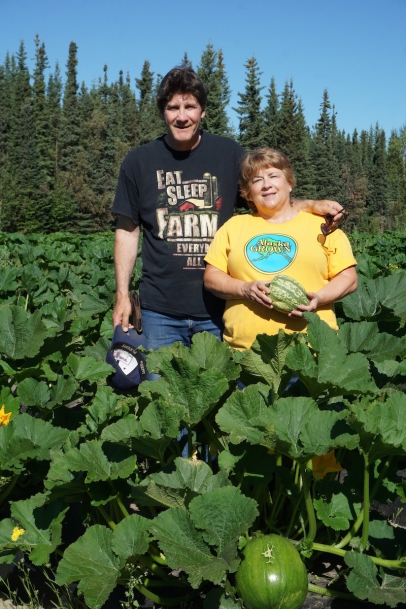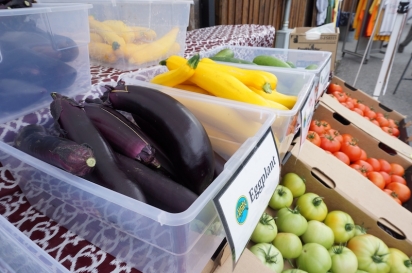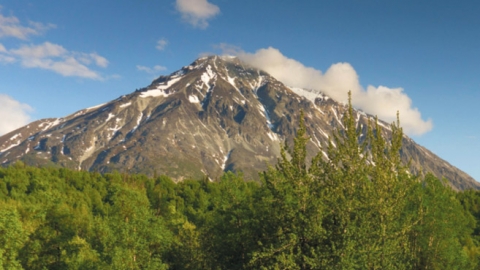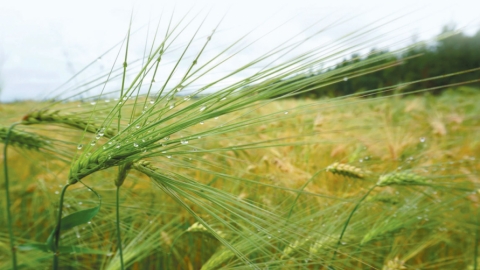Dart AM Farm: A Dream and a Promise
In the mountains west of Fairbanks, the scenic Eliot Highway rolls through thick birch and spruce forests, passing hidden places where hot water seeps up from the ground. After splitting off from the Dalton Highway, the Eliot turns into a bone-rattling, teeth-chattering, tire-popping gravelly dirt road that ends 80 miles later in the quiet community of Manley Hot Springs.
During the early 20th century, this place was once a supply center for miners in the nearby Eureka and Tofty districts, and at one point hosted a resort built by John Karshner, an enterprising prospector who also grew food for the miners on his homestead. Today, this tiny community hosts a roadhouse, school, post office, gas station, and general store. Adventurous out-of-towners can soak in the hot springs at the bath house. Tubs filled with geothermal hot water take center stage in this greenhouse oasis filled with tropical plants, exotic flowers, and hanging grapevines.
Dart AM Farms is located on the other side of the hill from the bath house. For the past decade, John Robert Dart has grown vegetables on this piece of land chiseled out of the forest. In addition to three acres of field crops, the farm also includes high tunnels and commercial greenhouses heated by geothermal water. A visit to the farm offers a glimpse into the complexity of a commercial-scale vegetable operation in an isolated Interior Alaska community. Each week in the summer, John loads vegetables onto a truck that he drives 160 miles to Fairbanks. Christine, his wife and vice president of the farm, sells vegetables at the Saturday Tanana Valley Farmers Market.
Although a towering figure at 6’ 1”, Farmer John is a gentle giant with a green thumb and a passion for agriculture. He walks at a steady, unhurried pace, taking care of tasks along the way. Weeding. Watering. Checking on solar panels and battery banks. Although constantly managing multiple projects, he is also generous with his time and knowledge. A conversation with John is an in-depth explanation of any given topic, ranging from how to identify and remedy mineral deficiencies, to the technical details of a water-pumping windmill, to the remarkable ability of eggplant to soak up flavor and enrich a dish.
When first pumped out of the ground, the geothermally-heated water at the farm is 120˚ F. In one hot house, warm water runs in tubes underneath rows of eggplants, cucumbers, basil, peppers, and tomatoes. Another greenhouse shelters trellised walls of bean plants. Busy bees also live here and pollinate purple and white flowers. “I just love growing things, but I love doing it on a big scale,” says John, whose farm produces several thousand pounds of vegetables each season, including specialties such as melons and strawberries. Any mention of squash leads to a dizzying litany of varieties that he grows in the outdoor fields: Mustang, Cougar, Blue Hubbard, Jumbo Pink Banana, Boston Marrow, and Festival to name a few. “The best tasting squashes are the ones like the Hubbard, with big long vines that can take in the nutrients and the long Alaska day length,” he explains. “As the temperatures cool down, they accumulate all these wonderful sugars.”
Lifelong hunger for knowledge
John was born in Minnesota where he grew up hunting, fishing, and trapping, in addition to working on a 200-acre dairy farm and reading The American Vegetable Grower magazine. In 1969 he came to Manley Hot Springs on a family visit and fell in love with Alaska. He returned to Alaska in 1975, just three days after graduating high school. He lived in Manley while helping his uncle with his geothermal greenhouses by Karshner Creek. John also worked at the local fish plant and on the trans-Alaska pipeline. He studied at the University of Alaska Fairbanks (UAF) and graduated from Purdue University with a dual major in agricultural engineering and agricultural education. He returned to Alaska where he worked as an operating engineer on the pipeline before starting graduate school. “The word that epitomizes him is driven,” shares Pat Holloway, retired UAF professor of horticulture. “He was a phenomenal student, one of those people that never stopped asking questions.”
John earned his graduate teaching credential at the University of California Davis while also working in the agricultural engineering department. He returned again to Interior Alaska where he managed a farm in Ruby that was run by the Yukon Koyukuk school district. Later, he taught science and vocational agriculture at North Pole High School for over a decade before working as a roving engineer for state of Alaska.
After retiring from the state, John purchased land in Manley Hot Springs from his Aunt Gladys. There, he started his own farm on the other side of the hill from where he first began his Alaskan life, growing vegetables with his uncle. “Being a jack of all trades served me well. A farmer has to do so many different kinds of things. You have to be a mechanic, an operator, finance person, and a horticulturalist.”
Each year brings different dilemmas. In 2018, John has already dealt with high snowfall that delayed planting, followed by a cold wet spring that threatened his entire squash planting with chilling injury. “You can never know enough about this livelihood. There’s always something new to learn. There’s always a new challenge.” Throughout the summer, ash rained down as massive forest fires blocked the sun with thick smoke and coated everything in fine soot. “Beans hate smoke,” asserts John. Still, perseverance prevails. “You never have control over Mother Nature. You have to be very accepting of what’s thrown at you,” comments John. “It is what it is.”
Ongoing challenges to farming in Manley include the high cost of pumping hot water, transporting equipment and supplies to the farm and transporting vegetables to faraway markets in Fairbanks and beyond. The farm is the ultimate matrix that combines all of John’s skills as a farmer, scientist, and engineer. Here, he tries new things and problem-solves as necessary, all while growing plants on a large scale. “Once he has a question he goes into it with such depth that he really does develop the expertise on something,” observes Holloway. “And that’s what he’s done with this whole Manley project. He’s pretty much had to invent everything that he’s done out there.”
John’s determination to continue farming in Manley is absolute. “It was a promise I made to my Aunt Gladys that I would do this.” He turns 62 this year, and he hopes to continue to farm for another decade. Still, he is concerned about the barriers for new farmers. “We farmers have to be willing to share the information and train the next generation, or else we’re going to be a bunch of old people starving to death!” He is always on the lookout for young people who want to come out to the farm and learn. “Everybody who comes to work for me comes with a skill set and an inner talent. My job is to figure out how to teach them what they need to know in order to be successful.”
Jennifer Becker is a young farmer who first met John in 2011 just as she was starting her own farm, Pioneer Produce. During her first season, John helped her by starting plants in his greenhouse. She spent the following spring in Manley to learn more about greenhouse management while starting plants for both of their farms. “A lot of farmers are super busy, and John is no exception, but he always will take the time to answer my questions, or listen to me complain when I'm discouraged,” she says. John’s optimism and encouragement have been inspiring, and she appreciates John as both a mentor and a good friend, she adds.
“In order for Alaskan ag to flourish, we just need more farmers,” says John. “Everybody has their niche. And I applaud all of it.”
Farm Evolution
John considers farming to be year-round work. After the growing season ends, he begins researching new ideas and planning for the next one. “You should see our house in the winter,” laughs Christine. “There’s seed catalogs all over and drawings of the field as to what might go where. And lots of equipment catalogs.” The farm has undergone many projects and configurations, such as the Manley U-pick and delivering vegetables via airplane. Recently, John has been impressed by new partnerships with innovative Alaskan food entrepreneurs such as Kyla Byers at Arctic Harvest Deliveries in Anchorage. John is growing vegetables especially for her CSA boxes, including high-demand crops such as winter squash that are not widely produced in the Mat-Su Valley.
John is also teaming up with Kelly and Travis Eggelston of Arctic Harvest Farm Distillery near Eielson to grow vegetables for fall harvest events to promote agritourism. “A blossom rot tomato has the highest flavor content because it’s been stressed,” proclaims John. “We can’t sell them so we keep those and whack off the end. The flavor is so intense you just fall in love with it!” Farmer John’s character follows these same principles. A beloved Alaskan farmer who thrives on the complexity of operating a commercial farm in a place that is both remote and unpredictable.







